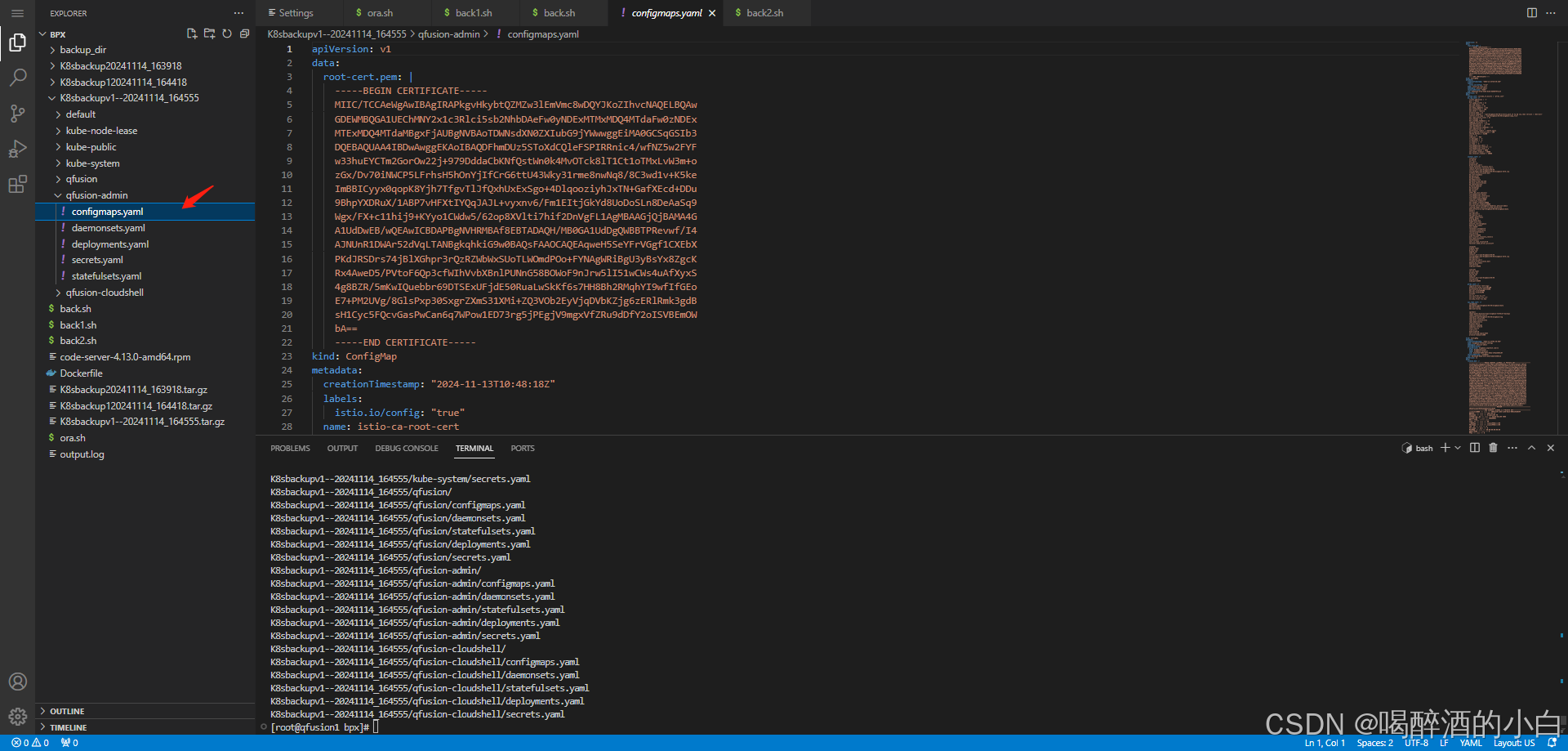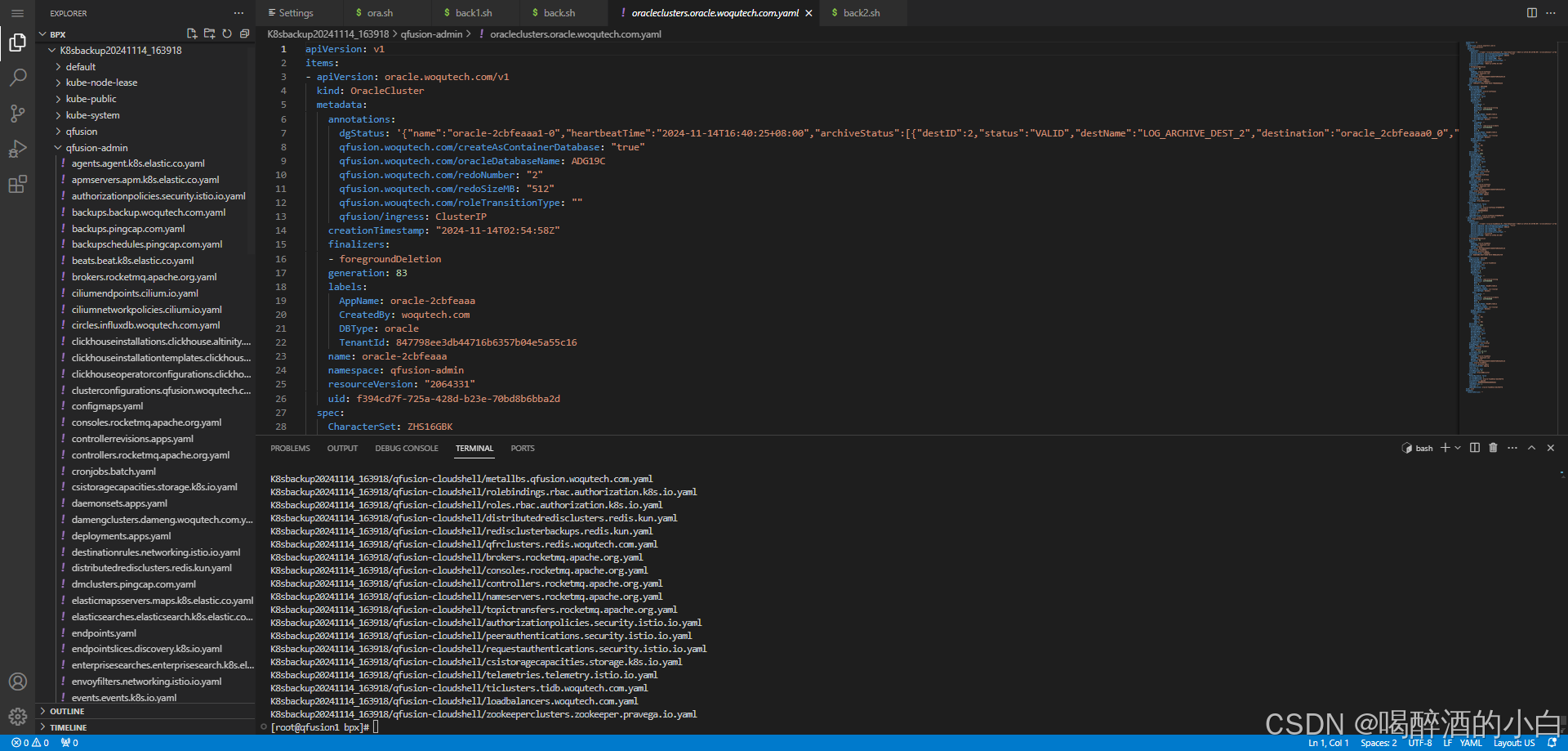备份k8s集群中资源
该脚本将备份所有资源为一个 YAML 文件,并将 ConfigMap、Secret、CronJob 分别备份到它们各自的 YAML 文件中。您可以根据需要选择备份的资源类型,并将其保存到相应的 YAML 文件中。最后,脚本将压缩备份目录并删除原始目录。您可以根据需要修改备份的资源类型,并将其保存到相应的 YAML 文件中。该脚本将逐个备份ConfigMap、DaemonSet、StatefulSe
·
Pod
#!/bin/bash
# 指定保存目录
SAVE_DIR="./pods_yaml"
# 创建保存目录
mkdir -p $SAVE_DIR
# 获取所有pod名称
PODS=$(kubectl get pods --all-namespaces -o jsonpath='{range .items[*]}{.metadata.namespace}/{.metadata.name}{"\n"}{end}')
# 循环遍历所有pod,获取yaml文件并保存
for POD in $PODS
do
NAMESPACE=$(echo $POD | cut -d '/' -f 1)
NAME=$(echo $POD | cut -d '/' -f 2)
kubectl get pod $NAME -n $NAMESPACE -o yaml > $SAVE_DIR/$NAMESPACE-$NAME.yaml
done
echo "保存完成!"
All 1
这里是备份Kubernetes各种资源为YAML文件的脚本,分别备份了ConfigMap、DaemonSet、StatefulSet、Deployment等资源:
#!/bin/bash
# Set the backup directory
backup_dir=K8sbackupv1--$(date +%Y%m%d_%H%M%S)
mkdir -p $backup_dir
# Backup ConfigMaps in all namespaces
for ns in $(kubectl get namespaces -o name | cut -d '/' -f 2); do
mkdir -p $backup_dir/$ns
kubectl get configmaps -o name -n $ns | xargs -I{} kubectl get {} -n $ns -o yaml > $backup_dir/$ns/configmaps.yaml
done
# Backup DaemonSets in all namespaces
for ns in $(kubectl get namespaces -o name | cut -d '/' -f 2); do
mkdir -p $backup_dir/$ns
kubectl get daemonsets -o name -n $ns | xargs -I{} kubectl get {} -n $ns -o yaml > $backup_dir/$ns/daemonsets.yaml
done
# Backup StatefulSets in all namespaces
for ns in $(kubectl get namespaces -o name | cut -d '/' -f 2); do
mkdir -p $backup_dir/$ns
kubectl get statefulsets -o name -n $ns | xargs -I{} kubectl get {} -n $ns -o yaml > $backup_dir/$ns/statefulsets.yaml
done
# Backup Deployments in all namespaces
for ns in $(kubectl get namespaces -o name | cut -d '/' -f 2); do
mkdir -p $backup_dir/$ns
kubectl get deployments -o name -n $ns | xargs -I{} kubectl get {} -n $ns -o yaml > $backup_dir/$ns/deployments.yaml
done
# Backup Secrets in all namespaces
for ns in $(kubectl get namespaces -o name | cut -d '/' -f 2); do
mkdir -p $backup_dir/$ns
kubectl get secrets -o name -n $ns | xargs -I{} kubectl get {} -n $ns -o yaml > $backup_dir/$ns/secrets.yaml
done
# Compress the backup directory
tar -czvf $backup_dir.tar.gz $backup_dir
# # Delete the backup directory
# rm -rf $backup_dir
您可以根据需要修改备份的资源类型,并将其保存到相应的 YAML 文件中。该脚本将逐个备份ConfigMap、DaemonSet、StatefulSet、Deployment等资源,以便您可以更好地控制备份的内容。

All 2
以下是备份Kubernetes所有资源为YAML文件的脚本,包括所有资源类型:
#!/bin/bash
# Set the backup directory
backup_dir=K8sbackup$(date +%Y%m%d_%H%M%S)
mkdir -p backup_dir
# Get all namespaced API resources that support the list verb
resources=$(kubectl api-resources --verbs=list --namespaced -o name)
# Backup each resource
for resource in $resources; do
# Create a directory for each namespace
for ns in $(kubectl get namespaces -o name | cut -d '/' -f 2); do
mkdir -p $backup_dir/$ns
# Backup the resource in the current namespace
kubectl get $resource -n $ns -o yaml > $backup_dir/$ns/$resource.yaml
done
done
# Compress the backup directory
tar -czvf $backup_dir.tar.gz $backup_dir
# # Delete the backup directory
# rm -rf $backup_dir

更多推荐
 已为社区贡献27条内容
已为社区贡献27条内容









所有评论(0)